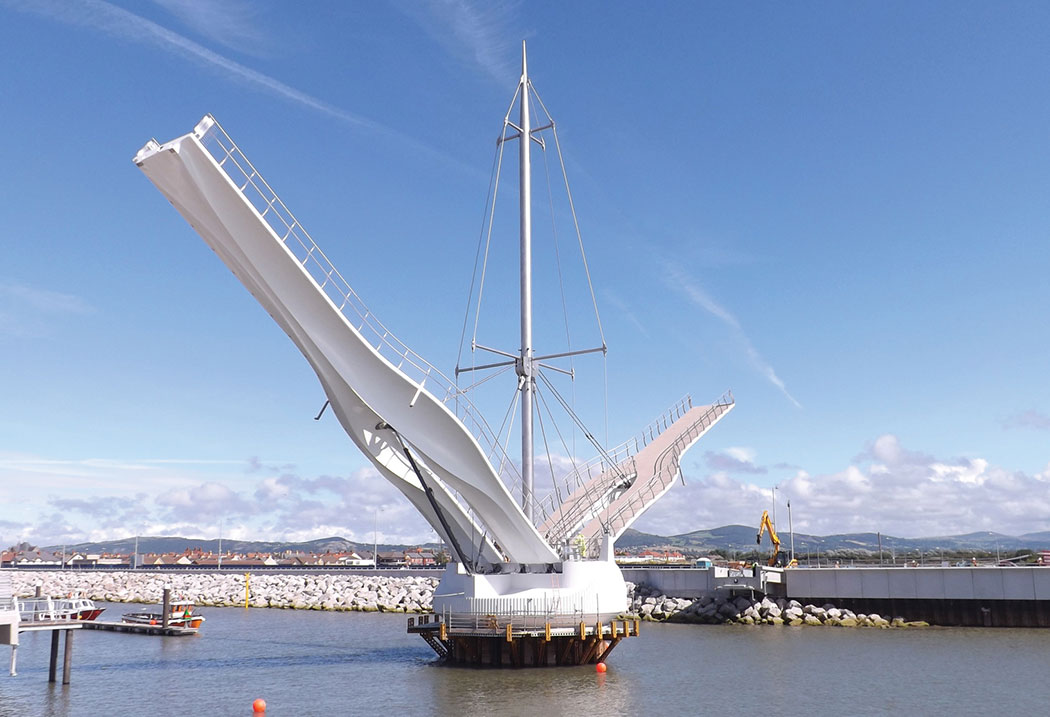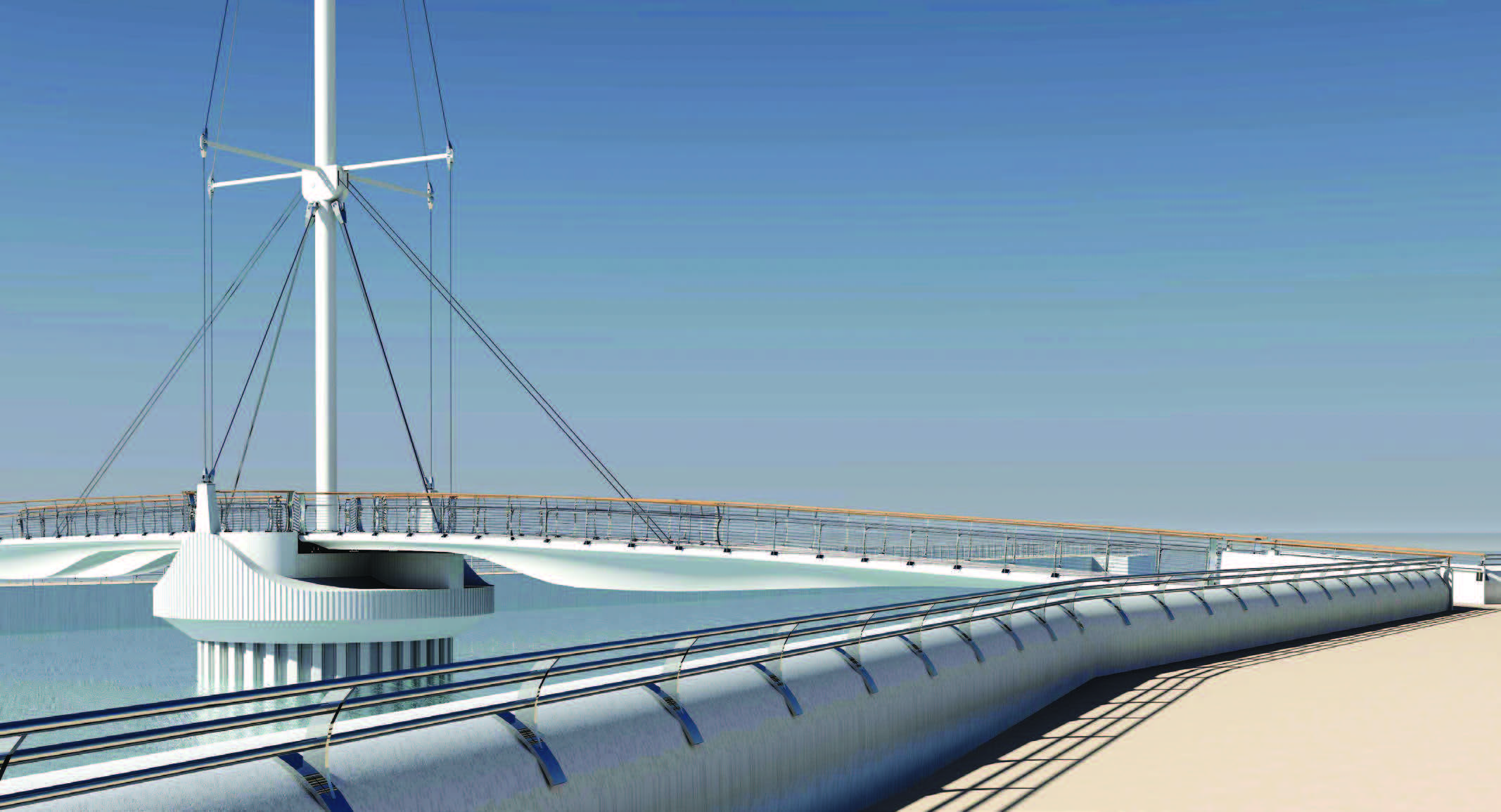Case Study

The new lifting bridge over Rhyl Harbour in North Wales, serves as an additional crossing for pedestrians and cyclists. Spanning the River Clwyd from Rhyl’s West Parade to a newly created public area on the Kinmel Bay side of the river, the elegantly opening lightweight bridge named “Pont y Ddraig” has already become an iconic landmark attracting visitors. Hundreds watched the two lightweight composite decks – or dragon wings – being lifted into place in early Summer. The new lifting bridge over Rhyl Harbour in North Wales, serves as an additional crossing for pedestrians and cyclists. Spanning the River Clwyd from Rhyl’s West Parade to a newly created public area on the Kinmel Bay side of the river, the elegantly opening lightweight bridge named “Pont y Ddraig” has already become an iconic landmark attracting visitors. Hundreds watched the two lightweight composite decks – or dragon wings – being lifted into place in early Summer.
In response to a tender call from Denbighshire County Council, Ramboll and Dawnus developed a design proposal consisting of two mirroring, 30 metre long decks, which are hinged on a central caisson and lifted by cables running up to a central mast. Almost 50 metres tall, the mast is stayed by a rigging similar to a sail boat’s and makes the bridge and the harbour visible from miles around. The mast houses the pulley mechanism and lifting cables. To balance the lift, the decks, engineered by Gurit (UK) and built at AM Structures using many Gurit materials, are lifted simultaneously.
To give access to moorings upstream of the bridge, the new pedestrian and bike crossing is likely to open many times a day. So, the Denbighshire County Council was interested in minimising the use of energy for lifting. The use of advanced molded fibre reinforced plastic (FRP) for the bridge decks was an integral part of the design concept to save as much weight as possible to make lifting cycles fast and energy efficient. It also allowed a sculptured deck shape, which provides a striking, iconic sight when the bridge is opened.
Ramboll approached AM Structures in early 2009 to review the concept of the bridge deck construction and to provide feedback on the construction and weight estimate for the FRP decks. AM Structures asked Gurit to review the structure of the bridge, and initial studies confirmed that the bridge concept was feasible with some minor changes in the geometry, and that the FRP decks would result in considerable savings compared with a steel structure.
The design proved to be successful, and AM Structures was approached for the fabrication of the decks. Gurit was contracted by AM Structures to carry out the detailed engineering of the bridge decks, which presented some interesting challenges. The decks are very slender, partially for aesthetic reasons, but also to ensure that the inshore lifeboat would have sufficient headroom to pass under the lowered bridge at all tide levels.
Due to the lightweight and slender structure of the decks, detailed consideration of the dynamic behaviour of the bridge under pedestrian loading was required. The bridge was designed with predominantly glass reinforcements with longitudinal stiffness enhanced by local planks of carbon fibre. Gurit made extensive use of finite element analysis to carry out transient dynamic analysis of the bridge using load models from Eurocodes. A number of load conditions were analyzed, corresponding to groups of pedestrians walking and running over the bridge, in addition to a crowd loading case. This analysis led to optimisation of the laminates for both longitudinal and torsional stiffness of the bridge decks to meet the required comfort criteria.
AM Structures built the decks using Gurit® Corecell™ M, Ampreg 21 resin, and a mixture of glass and carbon reinforcements supplied by Gurit. The build of the decks was already a spectacular sight. But the shipment from the Isle of Wight to the mainland, the transportation to Wales and the lifting of the decks into place, all attracted crowds.
The new crossing needed a catchy name. A naming competition was open to pupils at local primary schools. An independent panel considered over 30 names and finally selected “Pont y Ddraig”, as one student had suggested. By the middle of July, hundreds of people had flocked to Rhyl with their cameras to catch the moment when the second deck – or is it a Dragon wing? – was lifted into place. A large crane hoisted the 30m long, FRP deck into place.
Following installation, Gurit will now carry out a testing program to verify the dynamic behavior of the bridge, using in-house accelerometers and data acquisition equipment.
The official opening took place in October 2013, when all pupils who had participated in the naming competition led the first walk across the bridge.

